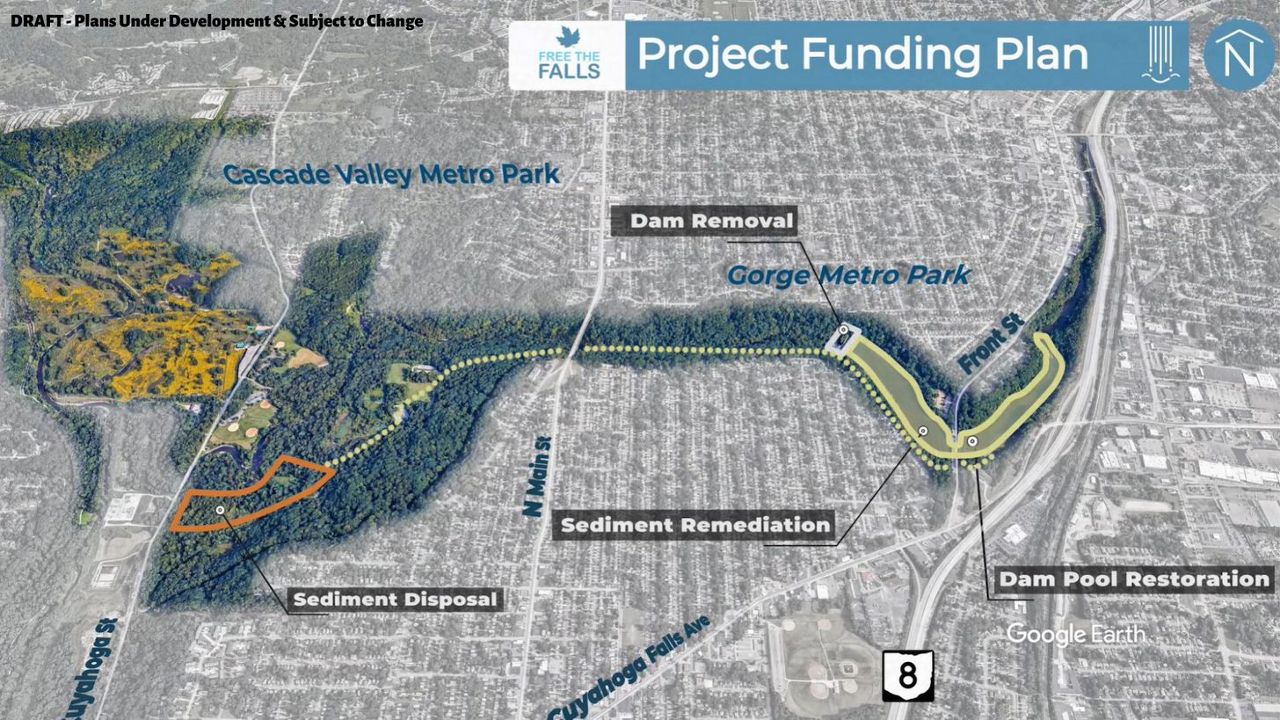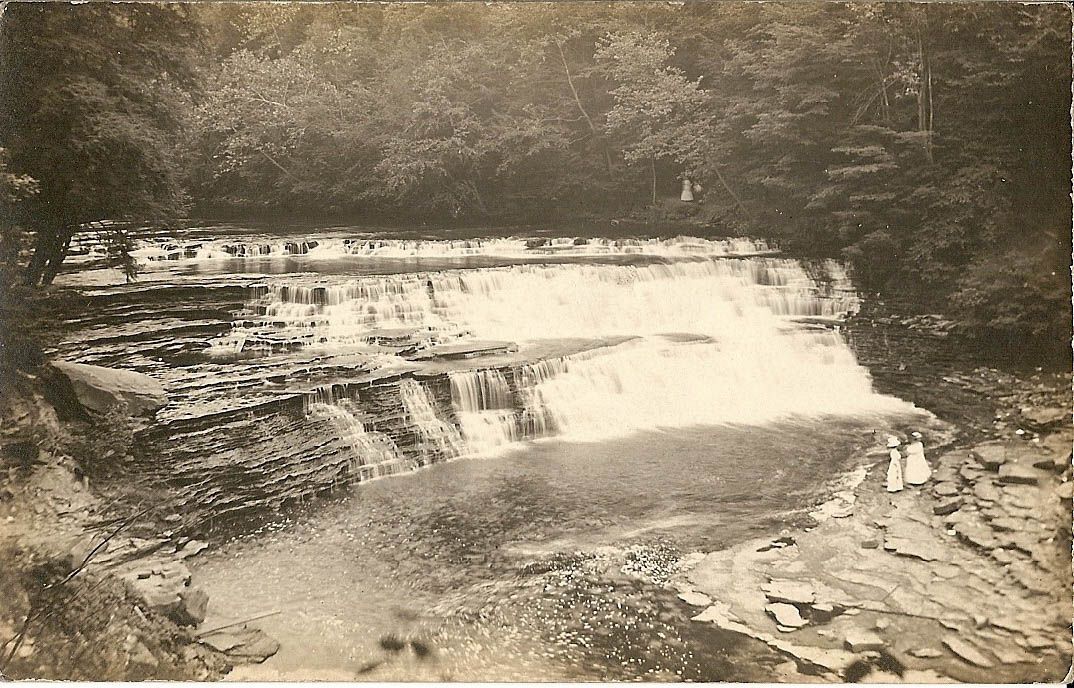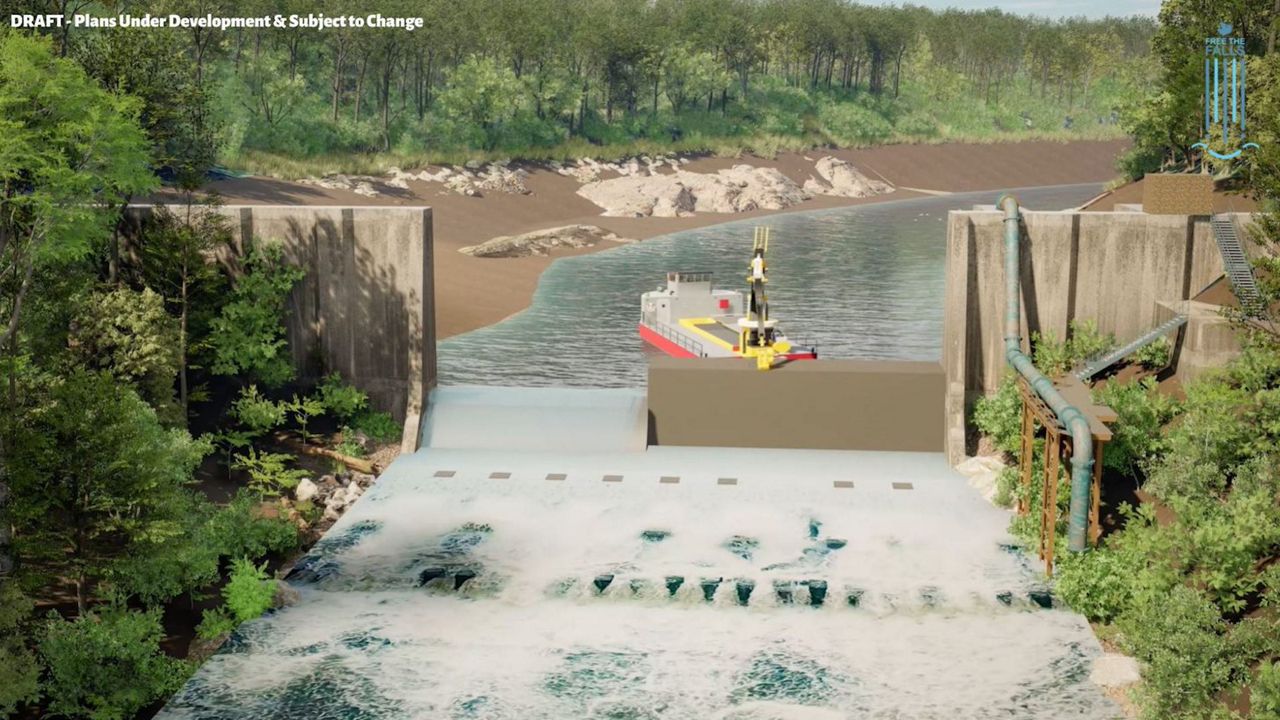CUYAHOGA FALLS, Ohio — While the world was under pandemic restrictions, environmental officials were pushing forward in planning a project to take down the Gorge Dam.
Residents filled a large meeting room at the Cuyahoga Falls Natatorium Monday night to get the first project updates since 2019, when the pandemic began prohibiting gathering. The standing-room-only meeting, which also was live-streamed, was hosted by Summit Metro Parks, in conjunction with the Ohio and U.S. EPAs.
More than 50 agencies, businesses and civic organizations are also participants in the project, said Metro Parks Executive Director Lisa King.
The 60-foot-high, 420-foot-wide mass of concrete is believed to be the final impediment in northeast Ohio to a healthy Cuyahoga River, officials said.
The dam, which straddles the river on the Cuyahoga Falls-Akron border, was built in 1911 for hydroelectricity and later used to cool water for a coal-fired power plant, said Summit Metro Parks Chief of Conservation Mike Johnson. It has served no purpose since 1991 when Ohio Edison discontinued operations there.
The estimated cost of the removal project, about $70 million pre-pandemic, now hovers around $130 million, with final costs available later this year, U.S. EPA officials said.
The bulk of that cost — more than $100 million — will be managing sediment, said Mary Beth Giancarlo, U.S. EPA project manager for sediment removal and disposal.
Conducted between 2009 and 2011, a U.S. EPA study found the sediment non-toxic in the 1.5-mile pool behind the dam, which means it can be removed without requiring confined disposal, the agency said.
Evaluation and testing for the design of the sediment removal and disposal have been underway over the past few years, with the chosen site a 30-acre footprint near the Chuckery area of the Cascade Valley Metro Park, off of Peck Road, Johnson said.

The area is considered “low quality” and was a dumping area before Metro Parks took it over, he said.
“We did look for the best, most environmentally friendly place we could put this and that area historically had been abused in the past,” he said.
Between now and February, the site will be cleared of trees and vegetation so additional soil samples can be collected and the final design ready by spring of 2023, Giancarlo said.
Engineering evaluations are ongoing to ensure bridges and other structures along the river, as well as the river banks, are stable enough to withstand the river when the dam comes down, she said.
Once funding is approved, the sediment disposal site can be prepared and any stabilization that might be necessary completed, she said. If all is well, sediment dredging can begin in 2024.
The sediment will be mounded at the disposal and then overplanted so in about 10 years it will be covered with trees and other vegetation, she said.
Sediment removal is expected to take about two years, followed by dam removal which is planned for 2025-2026.
Funding for the work — sediment remediation, disposal site construction and dam removal —will come from federal, state and local sources, including U.S.EPA’s Great Lakes Restoration Initiative and the Great Lakes Legacy Act, officials said.

Akron was awarded an Ohio Department of Natural Resources grant, while the Ohio EPA was awarded Lake Erie Protection Fund grant from the Ohio Lake Erie Commission. Funding is also being provided by Summit Metro Parks and the Northeast Ohio Regional Sewer District.
The Gorge Dam is the last in a chain of dams from Kent to Cuyahoga Falls that have been demolished over the past several years. Once it is removed, the river will be able to naturally clean itself while migratory fish will be able to move freely again, officials said.
The dam removal project is branded “Free the Falls,” representing “Big Falls,” the multi-tiered waterfalls spanning the width of the Cuyahoga River, which will be visible for the first time in a century when the dam is removed.
In addition to a cleaner river, many water sports enthusiasts are looking forward to the dam’s removal because a freely flowing Cuyahoga River opens 2.5 miles of continuous Class III to Class V whitewater, officials said.
In Cuyahoga Falls, taking down two dams — the Powerhouse and Sheraton dams — opened the river to Class II to Class V rapids, supporting the many small businesses that now line the river downtown, said Mayor Don Walters.
“We know that Mother Nature is free flowing, and the rest of the river has exploded with activity — the inner tubing, the hiking, there's rock climbing now on the walls, fishing, all those things are important,” he said. “We need to open that up.”
Dam removal also led to the launch of the city's annual kayak race, which evolved into the Cuyahoga Falls Fest, organized by paddling athletes. Walters urged those in attendance to contact their representatives to encourage their support as project officials seek funding for the project.
Summit Metro parks will host the next Gorge Dam update meeting in spring 2023. To sign up to receive Free the Falls updates, visit the Metro Parks website.



